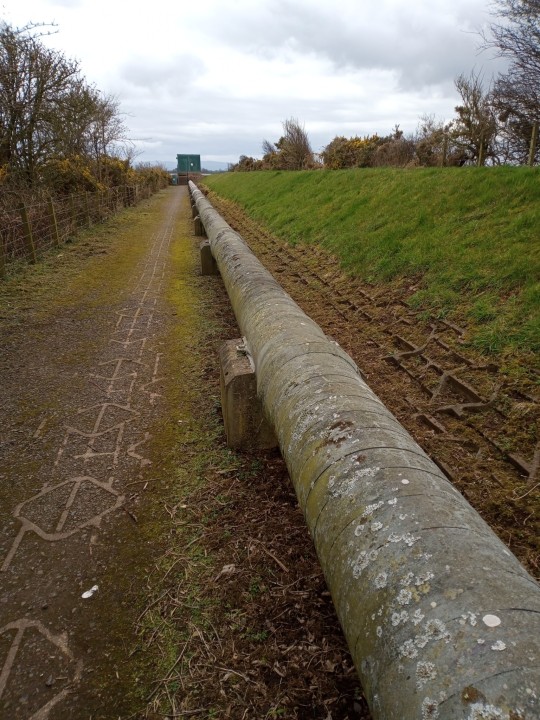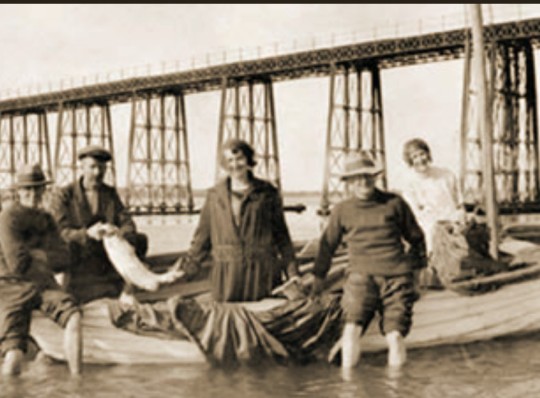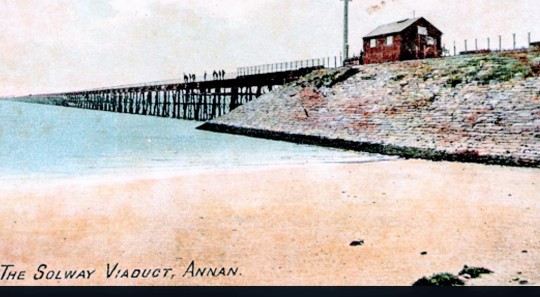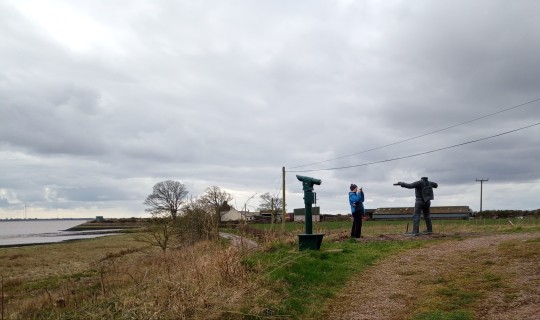#redgauntlet
Explore tagged Tumblr posts
Text
hmm I wonder if I could compel my friends to read Sir Walter Scott’s Redgauntlet by distributing it in substack form. On the one hand, it’s much longer than Kidnapped and has even more Scots (the language; there are actually more individual Englishmen in Redgauntlet I think), so would be more of a commitment; and it’s not Scott’s best novel even though it might be my favorite; on the other hand, it’s got intrigue, drama, humor, best friends, wandering fiddlers, long-lost families, Gothic motifs, and (@animate-mush) lawyers, plural. And when I made my high school friends read it for our book club they loved it. You’d love it too. Let me know if I should substack it actually. It is of course also free on PG.
#sir walter scott#redgauntlet#ooh I know what the tag would have to be#redgauntlet regularly#I might have to do it just for that
10 notes
·
View notes
Text
FOUR
The moon shone broad and bright upon the placid face of the Solway Firth, and showed a slight ripple upon the stakes, the tops of which were just visible above the waves.
SIR WALTER SCOTT, Redgauntlet (1824)
THE CLOCKS WENT forward today but there’d hardly be enough blue in the world to darn a sailor’s hanky. My ears, exposed after an out-of-season haircut, are red as hen’s heads as Nikki and I take in the windswept mudflats which Robert Burns called ‘this wild place of the world’. A heron pecks patina into flotsam; tuxedoed oystercatchers hurtle along the mud with their lame men’s gaits and then moan into a monochrome sky. To hoodwink their prey, plovers tap-dance on the beach pretending to be raindrops.
Three boys in shell suits stand around an observation viewer. ‘Quality’, offers the tallest of the trio, after discovering it isn’t coin-operated. He squints through it to England. ‘What the Butler saw’, I joke, ‘That’s where Edward the First cursed us before breathing his last.’ The three boys dander off, perplexed about butlers; an oyster-catcher pipes past, and a flock of timid redshanks retreats past the Altar Stane, more often than not under water, which has bounded the burgh of Annan since 1539.

Before they moved to Lochmaben Robert the Bruce’s ancestors had a castle at Annan, and a running track and park now sit beneath its tree-colonised motte. A stone from the castle, with an inscription related to the Bruces, was somehow acquired by an Annan antiquarian, who took it with him when he moved to Devon. It was returned in 1927 and is now incorporated within the town hall. There is a story that Archbishop, later Saint, Malachy put a curse on Annan. When he had dined with Bruce at the castle, Bruce had promised to spare the life of a condemned man. However, he reneged on the deal – with the result that a vampire allegedly ran loose in the town in which Thomas Carlyle later went to school.
Chop all the wood from boats that sailed in the Solway Firth, and Bonfire Night could be celebrated the length and breadth of Scotland until they launch the first zebra into space. Horn-helmeted raiders, Roman warriors, English incursors, pirates, kings, folk heroes, brigands, smugglers, and lovers. They all came and went with swords, fire, trade, romance or murder. Hadrian put his ‘Roman wall’ up at Bowness-on-Solway on the shoulder of England, a mile from where we stand – across a wath that was used by interlopers for centuries. That wath or ford can be walked when the tide is out, but you’d better know the currents intimately or you’ll be struggling in quicksand before your brain can contemplate the meaning of M’ Aidez.
From Cumberland’s tussocks – an official Area of Outstanding Natural Beauty since 1964 –trains used to smoke their way across the sea on the longest bridge in Europe. We gaze at England from a lichened mound of concrete and mudstone with mini-ferns curling out of Scotland like croziers. Behind us the trains passed through a cutting that has doubled for decades as a way for dog walkers undeterred by the pipeline running bang down the middle, through which Chapelcross Nuclear Power Station discharged its shit into the sea.


It’s March 2023. The first sod for the Solway Viaduct from Bowness-on-Solway to Annan was cut here 158 years ago today in a ceremony that featured ‘four navvies in smock frocks, red neckcloths, and white nightcaps ...... a mahogany barrow with the silver spade on their shoulders’. A cannon was fired, prayers were said, and big wigs sat in a decorated pavilion for their déjeuner à la forchette, and much speechifying and backslapping.


The idea for a viaduct had originated in 1830 in an anonymous pamphlet but The Cumberland Pacquet and Ware’s Advertiser called it ‘sublime, utopian, stupendous and bordering on certain of the Munchausen achievements’.
It took three years to build, but in 1881 ice floes wrecked it. It was repaired but it never quite recovered and was shut down in 1921. Notices went up to keep people off the bridge; however, thirsty Scots made their way across on Sundays to take advantage of more liberal English licensing laws, and there were cross-border romances for which the viaduct wasn’t a bridge too far. It was dismantled in 1935, and the scrap was recycled for armaments in Japan for its war with China. A signal box allegedly ended up being used as a garden shed.
What remains of a rusty tanker sits deck-deep in silt now behind an old warehouse that once rung with the sound of shipbuilders’ mallets. A local group pulled it out of view in 2020 with cash collected from flogging scrap bikes and shopping trolleys. Thousands of people once thronged the pier at Annan, an important shipbuilding port, whence steamers took folk to new worlds. A wooden lighthouse stood at Barnkirk point but it burned to the shore in 1975. Today a scarfed pensioner wheezes along the quay with smoky breath; and a subdued mongrel, oblivious of history, looks just as disconsolate.
Shawhill railway station, built on the verge of Annan for the viaduct traffic, is now a scrapyard. Back on the foreshore cinder path a decapitated man stands on a plinth – a bone of contention between his maker (who welds together bits of scrap and exhibits them) and others in the community, whom he regularly lambasts on his social media page. Metal Man began life in 2009 on a roundabout at the Tesco store in town, but he was beheaded in 2019. Since then, he has had a traffic cone for a head, then a football, a parrot’s head and a pig’s head. A month ago, a prankster sawed the statue’s haaf-net and fish off. Goodness knows how he ended up on the shore here where for generations real haaf-netters have battled the currents and tides.


Old Annanites speak of haaf-netting in reverential tones: it has been pursued since Viking times and is enshrined in royal charters. A haaf-net resembles a portable football goalmouth with a rectangular frame and three legs. The top beam of the frame is 18 feet long, the length of the oar of a longboat; when a fish swims into the net the frame’s legs float to the surface and the fish is netted and clobbered on the head with a nep, a priest or a killer. Well, that is what used to happen, but legislation introduced in 2016 bans the killing of salmon, and fewer and fewer men feel like paying the near £40 annual licence fee when they cannot take a single fish home. The tradition is certain to die out.
Leistering was another unusual form of fishing practised by the men of the Solway. A leister was a four-pronged, twenty-foot-long javelin, which killed fish in huge quantities. Richard Franck, a Cromwellian trooper, was the first person to report on Scotland’s salmon-fishing. The Cambridge-educated sea captain travelled through Carlisle, Dumfries, Glasgow, Stirling, Perth, Forfar, Loch Ness; Sutherland, Caithness, Cromarty, Aberdeen, Dundee, St. Andrews, Edinburgh, and Berwick.
Franck saw the mounted men of the firth galloping along the shallows spearing salmon (Northern Memoirs, 1694). Sir Walter Scott also gave leistering a mention. In Redgauntlet, Darsie Latimer wrote to Alan Fairford, of the day he was rescued from straying into the Solway quicksands: ‘...they chased the fish at full gallop, and struck them with their barbed spears, as you see hunters spearing boars in the old tapestry. The salmon, to be sure, take the thing more quietly than the boars; but they are so swift in their own element, that to pursue and strike them is the task of a good horseman, with a quick eye, a determined hand, and full command both of his horse and weapon.’ Latimer lingered on the sands and looked to the English shore that was ‘still gilded by the sun’s last rays, and, as it seemed, scarce distant a mile from me’.
For nearly half a century Chapelcross nuclear power station was a familiar landmark outside Annan. I was one of thousands of people who watched its four chimneys being demolished in 2007. Some souls were sentimental to the point of weeping. It was, indeed, the end of an era for a business that had employed three generations and had brought prosperity to a town which, in 1727, Daniel Defoe had found to be in ‘irrevocable decay’. It was hooray for me when the towers fell, though. Goodbye, plutonium. Goodbye, tritium. There have been proposals for a wood-burning power station there, using sustainable coppiced willows, and an adjacent solar farm has been approved. It remains mothballed.
In the 1960s there had been plans for an atomic metropolis that would have spanned the firth. There would have been a circuit-linear Solway City for 50,000 people, and a new airport. Forty years later there is another proposal – to route an ‘electric bridge’ from Annan to Bowness-on-Solway using energy from the world’s third greatest tidal bore. It would create a pedestrian and cycle route between England and Scotland with the usual razzmatazz for tourists and have enough in its locker to power 60,000 homes. The decommissioning of Chapelcross won’t be complete for some 80 years. Meanwhile, Annan’s dreams of a transformed harbour, a tourist hub, were thwarted in 2023 when an application for £8 million from Michael Gove, who had the Tory government’s portfolio for the Orwellian concept of ‘levelling up’, failed.
0 notes
Note
The Modern English “Witch” comes from the Middle English “Wicche.” The Middle English “Wicche” was, of course, a gender neutral version of the Old Englsh “Wicce” and “Wicca” – which were gendered. “Wicce” being the feminine form, and “Wicca” being the masculine.
You may recognize the masculine Old English word as it lends itself (albeit with a different pronunciation) to the most common form of modern day Witchcraft – the religion Wicca.
"Witch" was historically an insult by the way, it was something (both men and women) were accused of being, not something they self identified as. It's not until the 20th century with the birth of the Modern Witchcraft Movement that folks really started to self identify as them (and why you should never apply the word to a folk magic practitioner - current or historic - unless they choose it for themself).
Warlock comes from the Scots word meaning “oath breaker." It came to mean a person in league with the devil in Scots (the oath in question being one to Jesus Christ), and it didn’t enter the English language until the 19th century when Sir Walter Scott used it in his novel Redgauntlet. That fiction eventually entered the pop cultural consciousness – but those practicing Witchcraft have almost never actually used that word (save for a few who have decided to “reclaim” what they consider a slur).
Wizard has it's own story. The etymology for Wizard starts with the Old English “Wys” (or, y'know, “wise”) with the suffix “-ard, ” which was an intensifier we see in a lot of English words. It originally just meant like a philosopher, and didn’t come to refer to a “magic user” until the 1550s. If the theory of “wicce/wicca” being related to “wys” is true, it’d make these words related… but only loosely, considering that by the time Wizard meant anything connected to magic, “Witch” was already firmly in the language.
The only gendered word of these three in its historic use is arguably Warlock, but that doesn't mean it has to be.
Also, I like words.
apologies if this has been asked before, but what is the generally accepted difference between a witch, a wizard, and a warlock?
Personal preferences, in my opinion.
@traegorn knows a lot about the history behind the terms, if they would like to pitch in here. And @jasper-pagan-witch calls themselves a wizard instead of a witch these days, if they would like to pitch in as well.
346 notes
·
View notes
Text
Just thinking about that bit in Sir Walter Scott’s Redgauntlet, where a judge seeks the opinion of another judge, in the courtroom, by asking: ‘What say ye till’t, ye bitch?’
#It's pretty much the only thing I DO remember about Redgauntlet#I had questions after reading that#Maybe someday I will have answers
1 note
·
View note
Text
I know everyone is full of suggestions and most people don’t want to start another book right away, but one day....oneday, if y’all want another epistolatory novel, y’all should REEAAALLLY consider Redgauntlet by Sit Walter Scott.
I think Scott is honestly a great author because his characters are intentionally ridiculous while still being surrounded by good story. (He was also pretty woke for his time period jsut sayin)
12 notes
·
View notes
Photo

Steenie or Redgauntlet Pursued by a Goblin on Horseback, Eugène Delacroix, 1829, Metropolitan Museum of Art: Drawings and Prints
Harris Brisbane Dick Fund, 1931 Size: Image: 8 1/2 x 6 1/2 in. (21.6 x 16.5 cm) Sheet: 14 x 11 7/16 in. (35.5 x 29 cm) Medium: Unfinished lithograph; first state of three
https://www.metmuseum.org/art/collection/search/336634
11 notes
·
View notes
Text
now that I’ve got you all more or less used to early modern Scots via Kidnapped Weekly, is there any chance I can make anyone read Redgauntlet?
#it’s got folk music#(it’s got folk music used AS A SECRET CODE which is my favorite thing ever)#it’s got intense youthful friendship#it’s got a slightly disturbing love triangle#it’s got mysterious family secrets#it’s got an epistolary framing#it’s got an entirely unhistorical third Jacobite rising#it’s got Scots law#it’s got everything#it’s not even Sir Walter Scott’s best book#but it has everything I like#recommended for fans of gothicness and Scots law#(and folk music used as a secret code)#I’m not doing a substack though y’all have to just read it yourselves
6 notes
·
View notes
Text

@angryirene - Oh, I can answer that!
So, to review from the video, Warlock comes from a Scots word, and doesn't enter English until Sir Walter Scott used it in Redgauntlet in the 1820s.
“Witch” of course comes from the Middle English “Wicche.” The Middle English “Wicche” was, of course, a gender neutral version of the Old Englsh “Wicce” and “Wicca” – which were gendered. “Wicce” being the feminine form, and “Wicca” being the masculine.
While obviously Wicca borrows its name from the masculine form here, it's pronounced differently -- with the double "c" sounding like a "ch" in the Old English.
Fun fact, we don't actually know where "wicce" and "wicca" came from. Scholars literally disagree about their origin. The roots have been lost, a lot of different ideas have been proposed, but none are certain. Like we know it’s related to the Old English verb “wiccian,” but that just means “to bewitch” and no one know where that came from either. The OED just says it’s of “obscure origin” and just fucking gave up. Some scholars say it comes from the roots for “wise person.” Others say it comes from words meaning “to bend” or “to weave.” Another theory is that it just came from roots meaning “to gesture mysteriously.”
Literally almost no one agrees - though that hasn't stopped plenty of witchcraft books asserting a single answer for decades with unearned confidence. 😆
But, uh, that's all an aside. You asked about "Wizard."
Let's answer that.
The etymology for Wizard is completely different. It just comes from the Old English "Wys" (or, y'know, "wise") with the suffix "-ard, " which was an intensifier we see in a lot of English words. It originally just meant like a philosopher, and didn’t come to refer to a “magic user” until the 1550s. If the theory of "wicce/wicca" being related to "wys" is true, it'd make these words related... but only loosely, considering that by the time Wizard meant anything connected to magic, "Witch" was already firmly in the language.
Witch vs Warlock
248 notes
·
View notes
Photo

The Bridal of Janet Dalrymple
Sir Walter Scott (1771-1832)
Walter Scott, founder of the romantic historical novel, was born in Edinburgh in 1771. He entered his father’s law office, but before long gave up law for literature. His first works were ballads and long narrative poems. In 1814 he published the novel Waverley, which established his position as a writer. At the very height of his brilliant career he found himself morally obliged to pay off an enormous debt, and spent the rest of his life trying to do so. Scott wrote several short stories. The Bridal of Janet Dalrymple, not so well known as the far longer Wandering Willie’s Tale from Redgauntlet, is a well-written and (for Scott) surprisingly short and closely-woven narrative.
The present edition is reprinted from the volume, Scottish Love Tales, London, no date.
The Bridal of Janet Dalrymple
Miss Janet Dalrymple, daughter of the first Lord Stair, and Dame Margaret Ross, had engaged herself without the knowledge of her parents to the Lord Rutherford, who was not acceptable to them either on account of his political principles, or his want of fortune. The young couple broke a piece of gold together, and pledged their troth in the most solemn manner; and it is said the young lady imprecated dreadful evils on herself should she break her plighted faith.
Shortly after, a suitor who was favored by Lord Stair, and still more so by his lady, paid his addresses to Miss Dalrymple. The young lady refused the proposal, and being pressed on the subject, confessed her secret engagement. Lady Stair, a woman accustomed to universal submission (for even her husband did not dare to contradict her), treated this objection as a trifle, and insisted upon her daughter yielding her consent to marry the new suitor, David Dunbar, son and heir to David Dunbar of Baldoon, in Wigtonshire.
The first lover, a man of very high spirit, then interfered by letter, and insisted on the right he had acquired by his troth plighted with the young lady. Lady Stair sent him for answer, that her daughter, sensible of her undutiful behavior in entering into a contract unsanctioned by her parents, had retracted her unlawful vow, and now refused to fulfil her engagement with him.
The lover in return declined positively to receive such an answer from anyone but his mistress in person; and as she had to deal with a man who was both of a most determined character, and of too high condition to be trifled with, Lady Stair was obliged to consent to an interview between Lord Rutherford and her daughter.
Source and more information: https://private.tourguideensar.com/the-bridal-of-janet-dalrymple-part-1/
0 notes
Photo

Scottish Love Tales
Sir Walter Scott (1771-1832)
Walter Scott, founder of the romantic historical novel, was born in Edinburgh in 1771. He entered his father’s law office, but before long gave up law for literature. His first works were ballads and long narrative poems. In 1814 he published the novel Waverley, which established his position as a writer. At the very height of his brilliant career he found himself morally obliged to pay off an enormous debt, and spent the rest of his life trying to do so. Scott wrote several short stories. The Bridal of Janet Dalrymple, not so well known as the far longer Wandering Willie’s Tale from Redgauntlet, is a well-written and (for Scott) surprisingly short and closely-woven narrative.
The present edition is reprinted from the volume, Scottish Love Tales, London, no date.
The Bridal of Janet Dalrymple
Miss Janet Dalrymple, daughter of the first Lord Stair, and Dame Margaret Ross, had engaged herself without the knowledge of her parents to the Lord Rutherford, who was not acceptable to them either on account of his political principles, or his want of fortune. The young couple broke a piece of gold together, and pledged their troth in the most solemn manner; and it is said the young lady imprecated dreadful evils on herself should she break her plighted faith.
Shortly after, a suitor who was favored by Lord Stair, and still more so by his lady, paid his addresses to Miss Dalrymple. The young lady refused the proposal, and being pressed on the subject, confessed her secret engagement. Lady Stair, a woman accustomed to universal submission (for even her husband did not dare to contradict her), treated this objection as a trifle, and insisted upon her daughter yielding her consent to marry the new suitor, David Dunbar, son and heir to David Dunbar of Baldoon, in Wigtonshire.
The first lover, a man of very high spirit, then interfered by letter, and insisted on the right he had acquired by his troth plighted with the young lady. Lady Stair sent him for answer, that her daughter, sensible of her undutiful behavior in entering into a contract unsanctioned by her parents, had retracted her unlawful vow, and now refused to fulfil her engagement with him.
The lover in return declined positively to receive such an answer from anyone but his mistress in person; and as she had to deal with a man who was both of a most determined character, and of too high condition to be trifled with, Lady Stair was obliged to consent to an interview between Lord Rutherford and her daughter.
S: https://balkan.privatetours.info/the-bridal-of-janet-dalrymple-part-1/
0 notes
Text
It's amazing how folks who don't know shit about the etymology of words will come on and declare things with such confidence. Warlock was a Scots word meaning betrayer of the covenant (with god) that didn't enter English usage until Sir Walter Scott used it in Redgauntlet.
Witch is gender neutral and always has been, and it takes willful ignorance to not know that at this point.
So anyway, 'witch' is a gender neutral term.
4K notes
·
View notes
Photo

Scottish Love Tales
Sir Walter Scott (1771-1832)
Walter Scott, founder of the romantic historical novel, was born in Edinburgh in 1771. He entered his father’s law office, but before long gave up law for literature. His first works were ballads and long narrative poems. In 1814 he published the novel Waverley, which established his position as a writer. At the very height of his brilliant career he found himself morally obliged to pay off an enormous debt, and spent the rest of his life trying to do so. Scott wrote several short stories. The Bridal of Janet Dalrymple, not so well known as the far longer Wandering Willie’s Tale from Redgauntlet, is a well-written and (for Scott) surprisingly short and closely-woven narrative.
The present edition is reprinted from the volume, Scottish Love Tales, London, no date.
The Bridal of Janet Dalrymple
Miss Janet Dalrymple, daughter of the first Lord Stair, and Dame Margaret Ross, had engaged herself without the knowledge of her parents to the Lord Rutherford, who was not acceptable to them either on account of his political principles, or his want of fortune. The young couple broke a piece of gold together, and pledged their troth in the most solemn manner; and it is said the young lady imprecated dreadful evils on herself should she break her plighted faith.
Shortly after, a suitor who was favored by Lord Stair, and still more so by his lady, paid his addresses to Miss Dalrymple. The young lady refused the proposal, and being pressed on the subject, confessed her secret engagement. Lady Stair, a woman accustomed to universal submission (for even her husband did not dare to contradict her), treated this objection as a trifle, and insisted upon her daughter yielding her consent to marry the new suitor, David Dunbar, son and heir to David Dunbar of Baldoon, in Wigtonshire.
The first lover, a man of very high spirit, then interfered by letter, and insisted on the right he had acquired by his troth plighted with the young lady. Lady Stair sent him for answer, that her daughter, sensible of her undutiful behavior in entering into a contract unsanctioned by her parents, had retracted her unlawful vow, and now refused to fulfil her engagement with him.
The lover in return declined positively to receive such an answer from anyone but his mistress in person; and as she had to deal with a man who was both of a most determined character, and of too high condition to be trifled with, Lady Stair was obliged to consent to an interview between Lord Rutherford and her daughter.
S: https://balkan.privatetours.info/the-bridal-of-janet-dalrymple-part-1/
0 notes
Photo

Scottish Love Tales
Sir Walter Scott (1771-1832)
Walter Scott, founder of the romantic historical novel, was born in Edinburgh in 1771. He entered his father’s law office, but before long gave up law for literature. His first works were ballads and long narrative poems. In 1814 he published the novel Waverley, which established his position as a writer. At the very height of his brilliant career he found himself morally obliged to pay off an enormous debt, and spent the rest of his life trying to do so. Scott wrote several short stories. The Bridal of Janet Dalrymple, not so well known as the far longer Wandering Willie’s Tale from Redgauntlet, is a well-written and (for Scott) surprisingly short and closely-woven narrative.
The present edition is reprinted from the volume, Scottish Love Tales, London, no date.
The Bridal of Janet Dalrymple
Miss Janet Dalrymple, daughter of the first Lord Stair, and Dame Margaret Ross, had engaged herself without the knowledge of her parents to the Lord Rutherford, who was not acceptable to them either on account of his political principles, or his want of fortune. The young couple broke a piece of gold together, and pledged their troth in the most solemn manner; and it is said the young lady imprecated dreadful evils on herself should she break her plighted faith.
Shortly after, a suitor who was favored by Lord Stair, and still more so by his lady, paid his addresses to Miss Dalrymple. The young lady refused the proposal, and being pressed on the subject, confessed her secret engagement. Lady Stair, a woman accustomed to universal submission (for even her husband did not dare to contradict her), treated this objection as a trifle, and insisted upon her daughter yielding her consent to marry the new suitor, David Dunbar, son and heir to David Dunbar of Baldoon, in Wigtonshire.
The first lover, a man of very high spirit, then interfered by letter, and insisted on the right he had acquired by his troth plighted with the young lady. Lady Stair sent him for answer, that her daughter, sensible of her undutiful behavior in entering into a contract unsanctioned by her parents, had retracted her unlawful vow, and now refused to fulfil her engagement with him.
The lover in return declined positively to receive such an answer from anyone but his mistress in person; and as she had to deal with a man who was both of a most determined character, and of too high condition to be trifled with, Lady Stair was obliged to consent to an interview between Lord Rutherford and her daughter.
S: https://balkan.privatetours.info/the-bridal-of-janet-dalrymple-part-1/
0 notes
Photo

Steenie or Redgauntlet Pursued by a Goblin on Horseback, Eugène Delacroix, 1829, Metropolitan Museum of Art: Drawings and Prints
Harris Brisbane Dick Fund, 1931 Size: Image: 8 1/2 x 6 1/2 in. (21.6 x 16.5 cm) Sheet: 14 x 11 7/16 in. (35.5 x 29 cm) Medium: Unfinished lithograph; first state of three
https://www.metmuseum.org/art/collection/search/336634
6 notes
·
View notes
Photo

Scottish Love Tales
Sir Walter Scott (1771-1832)
Walter Scott, founder of the romantic historical novel, was born in Edinburgh in 1771. He entered his father’s law office, but before long gave up law for literature. His first works were ballads and long narrative poems. In 1814 he published the novel Waverley, which established his position as a writer. At the very height of his brilliant career he found himself morally obliged to pay off an enormous debt, and spent the rest of his life trying to do so. Scott wrote several short stories. The Bridal of Janet Dalrymple, not so well known as the far longer Wandering Willie’s Tale from Redgauntlet, is a well-written and (for Scott) surprisingly short and closely-woven narrative.
The present edition is reprinted from the volume, Scottish Love Tales, London, no date.
The Bridal of Janet Dalrymple
Miss Janet Dalrymple, daughter of the first Lord Stair, and Dame Margaret Ross, had engaged herself without the knowledge of her parents to the Lord Rutherford, who was not acceptable to them either on account of his political principles, or his want of fortune. The young couple broke a piece of gold together, and pledged their troth in the most solemn manner; and it is said the young lady imprecated dreadful evils on herself should she break her plighted faith.
Shortly after, a suitor who was favored by Lord Stair, and still more so by his lady, paid his addresses to Miss Dalrymple. The young lady refused the proposal, and being pressed on the subject, confessed her secret engagement. Lady Stair, a woman accustomed to universal submission (for even her husband did not dare to contradict her), treated this objection as a trifle, and insisted upon her daughter yielding her consent to marry the new suitor, David Dunbar, son and heir to David Dunbar of Baldoon, in Wigtonshire.
The first lover, a man of very high spirit, then interfered by letter, and insisted on the right he had acquired by his troth plighted with the young lady. Lady Stair sent him for answer, that her daughter, sensible of her undutiful behavior in entering into a contract unsanctioned by her parents, had retracted her unlawful vow, and now refused to fulfil her engagement with him.
The lover in return declined positively to receive such an answer from anyone but his mistress in person; and as she had to deal with a man who was both of a most determined character, and of too high condition to be trifled with, Lady Stair was obliged to consent to an interview between Lord Rutherford and her daughter.
S: https://balkan.privatetours.info/the-bridal-of-janet-dalrymple-part-1/
0 notes
Photo

The present edition is reprinted from the volume
Sir Walter Scott (1771-1832)
Walter Scott, founder of the romantic historical novel, was born in Edinburgh in 1771. He entered his father’s law office, but before long gave up law for literature. His first works were ballads and long narrative poems. In 1814 he published the novel Waverley, which established his position as a writer. At the very height of his brilliant career he found himself morally obliged to pay off an enormous debt, and spent the rest of his life trying to do so. Scott wrote several short stories. The Bridal of Janet Dalrymple, not so well known as the far longer Wandering Willie’s Tale from Redgauntlet, is a well-written and (for Scott) surprisingly short and closely-woven narrative.
The present edition is reprinted from the volume, Scottish Love Tales, London, no date.
The Bridal of Janet Dalrymple
Miss Janet Dalrymple, daughter of the first Lord Stair, and Dame Margaret Ross, had engaged herself without the knowledge of her parents to the Lord Rutherford, who was not acceptable to them either on account of his political principles, or his want of fortune. The young couple broke a piece of gold together, and pledged their troth in the most solemn manner; and it is said the young lady imprecated dreadful evils on herself should she break her plighted faith.
Shortly after, a suitor who was favored by Lord Stair, and still more so by his lady, paid his addresses to Miss Dalrymple. The young lady refused the proposal, and being pressed on the subject, confessed her secret engagement. Lady Stair, a woman accustomed to universal submission (for even her husband did not dare to contradict her), treated this objection as a trifle, and insisted upon her daughter yielding her consent to marry the new suitor, David Dunbar, son and heir to David Dunbar of Baldoon, in Wigtonshire.
The first lover, a man of very high spirit, then interfered by letter, and insisted on the right he had acquired by his troth plighted with the young lady. Lady Stair sent him for answer, that her daughter, sensible of her undutiful behavior in entering into a contract unsanctioned by her parents, had retracted her unlawful vow, and now refused to fulfil her engagement with him.
The lover in return declined positively to receive such an answer from anyone but his mistress in person; and as she had to deal with a man who was both of a most determined character, and of too high condition to be trifled with, Lady Stair was obliged to consent to an interview between Lord Rutherford and her daughter.
S: https://tour.ephesusday.com/the-bridal-of-janet-dalrymple-part-1/
0 notes